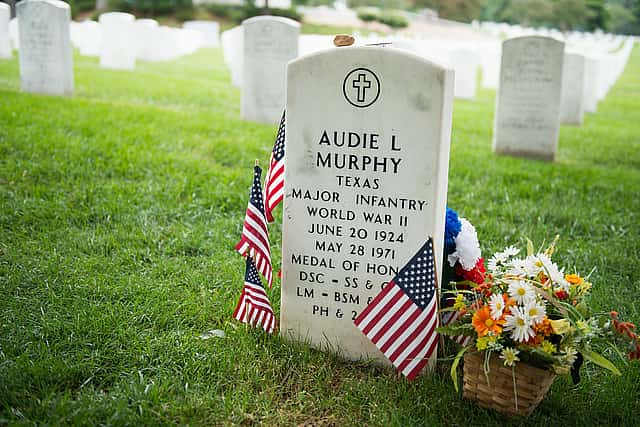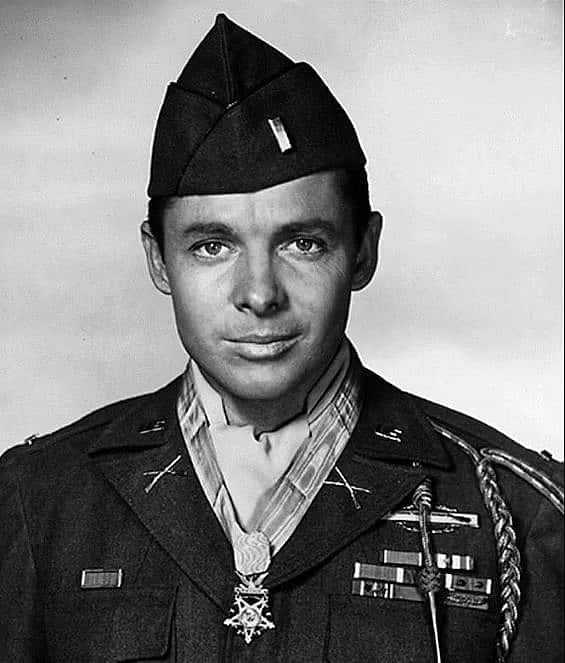
An Ordinary Man, an Extraordinary Legacy: Audie Murphy and the Colt Bisley
I may be branded by war, but I will not be defeated by it.” ― Audie Murphy, To Hell and Back
Audie Murphy’s 1905 Colt Bisley Flattop Target Revolver on display at the Cody Firearms Museum (not pictured) represents more than just a firearm. This modest artifact quietly honors an ordinary man who lived an extraordinary life and left us too soon. The Colt serves as a poignant reminder to museum visitors that heroism often emerges under extraordinary circumstances. Audie Murphy’s life demonstrates how an average kid from humble beginnings rose to heroic heights, leaving behind an enduring American legacy of courage and grit.

The Colt Bisley
The Colt Bisley on display functions as the target version of the Colt 1873 Single Action Army Revolver. Production of this elegant firearm ended in 1912, making it a rare model by the time actor Gary Cooper gifted it to Audie Murphy in 1945 as a gesture of deep respect for Murphy’s heroic wartime actions. The solid one-piece pearl handle even features grooves fitted to Murphy’s hand. The Bisley name originates from the famous Bisley shooting range, about thirty miles southwest of London in Brookwood-in-Surrey, England—the Wimbledon of target shooting tournaments and a cornerstone of British marksmanship heritage.
Humble Beginnings
While the Colt Bisley reflects Murphy’s decorated legacy as a soldier and later a Hollywood star, his path to prominence began in the most impecunious of settings. Born on June 20, 1925, in the rural farming dell of Kingston, Texas, Audie Murphy and his eleven brothers and sisters struggled greatly during the worst years of the Great Depression. To help support this family, Audie left school after fifth grade, harvesting cotton for a meager $1 per day. At age 16 Audie lost his mother, and his father later abandoned the family, leaving him to help support and feed his younger siblings. Precipitously, he honed his shooting skills while hunting for food in Texas; this made him a deadly marksman and would later serve him well during intense combat in World War II.
Valor Beyond Measure
After the Japanese attack on Pearl Harbor in December of 1941, Audie Murphy, like many young American men his age, wanted to join the Armed Forces. By falsifying his birth certificate, Murphy managed to enlist in the U.S. Army in June of 1942, at the tender age of seventeen. Initially assigned to the 15th infantry Regiment of the 3rd Infantry Division, Murphy saw combat in North Africa, Italy, France, and Germany. When one of his closest friends, Lattie Tipton, died beside him at the hands of Germans feigning surrender, Audie went on furious a rampage, killing or capturing all of the German soldiers on scene using a seized German machine gun and grenades. This earned him the Distinguished Service Cross, the first of many combat awards bestowed upon him. About five months later in January of 1945 near Holtzwihr, France with his company under attack, an already wounded Murphy mounted a burning tank destroyer and used its .50 caliber machine gun to annihilate dozens of German soldiers. Reinforcements arrived, and Murphy led a counterattack, driving the Germans completely from the battlefield and earning the prestigious Medal of Honor for his valorous actions that day. His Medal of Honor citation reads, “For an hour the Germans tried every available weapon to eliminate 2d Lt. Murphy, but he continued to hold his position and wiped out a squad which was trying to creep up unnoticed on his right flank. Germans reached as close as ten yards, only to be mowed down by his fire.”
Post-War Struggles
By the end of the war, Murphy had fought in nine major campaigns, killing more than 240 enemy soldiers. He earned three Purple Hearts for wounds sustained in battle and received every combat award possible, becoming the most decorated combat soldier ever to serve. The July 1945 issue of Life magazine prominently featured Audie Murphy on its cover, making him a household name and instant American hero, but this fame came at great cost. Privately, Murphy battled serious combat fatigue and disliked the continuous media attention. Insomnia, flashbacks, and fits of anger plagued his post-war life. Many sources report that he slept with a loaded pistol under his pillow, convinced he might come under attack in his sleep. Murphy’s courage cost him a normal life, with invisible wounds plaguing him well after the war ended. In 1950, attempting to return to normalcy in a lifestyle he understood, Murphy re-enlisted in the Texas Army National Guard, hoping that the military structure that had so defined his life would give him a restored sense of purpose.
The Hollywood Years
After seeing Murphy on the cover of Life, well-known actor James Gagney invited Murphy to Hollywood, playing a key role in helping an initially reluctant Murphy launch his acting career. Cagney encouraged Murphy to pursue acting lessons and invited him to the family ranch where Murphy learned horsemanship and film studies. Although shy and reserved on film, Audie Murphy starred in more than forty films, many of which were Westerns. In 1949 Murphy published To Hell and Back, his World War II memoir that chronicles his experiences across multiple battlefields and theaters of war. The best-selling book, heralded for its first-person, raw authenticity, later served as a basis for a 1955 film of the same name. Although Murphy played himself in the movie, reports indicate he did so reluctantly, even suggesting the casting of actor Tony Curtis in the role.
Untimely Passing
At the early age of forty-five, Audie Murphy died in a private plane crash in the Appalachian Mountains near Catawba, Virginia. News of his death ignited national headlines and Americans mourned the unexpected passing of a brave man. Buried with full military honors at Arlington National Cemetery, Murphy’s headstone draws visitors more than almost any other to this day. Greenville, Texas, Murphy’s hometown, celebrates Audie Murphy Day on June 20th of every year and his Medal of Honor remains on display at the Dallas Scottish Rite Library and Museum in Dallas, Texas.
When visitors view Murphy’s Colt Bisley Revolver in the Cody Firearms Museum, they step into the story of an unassuming, accidental celebrity who forfeited a regular life for the sake of American victory. This is the power of museums: they preserve the objects that convey our essential stories, precisely so we never forget.

Written By
Jane Gilvary
Jane Gilvary is a Content Specialist in the Public Relations Department at the Center of the West. She writes and manages web content and serves as editor of the Center’s monthly e-newsletter, Western Wire. Outside of work, Jane enjoys exploring Wyoming’s backcountry and discovering its hidden treasures.
